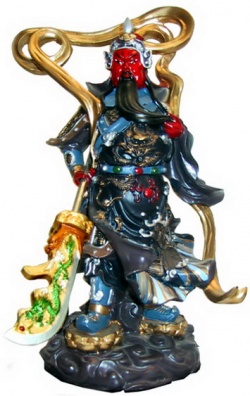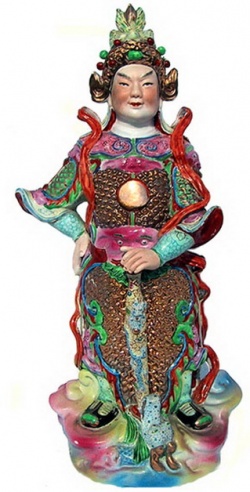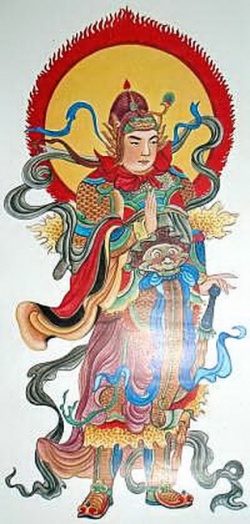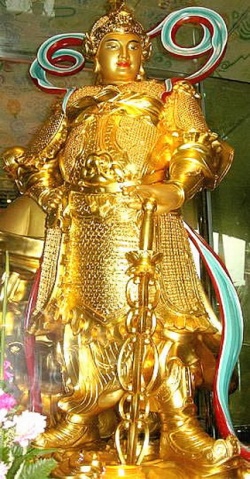The Temple Guardians
Lesser Bodhisattvas Who Guard the Bodhisattva Hall
In almost every Buddhist country, the temple gates are guarded by two or more fearsome figures.
Why is this?
Explanations abound. One that I am particularly fond of (aside from the obvious idea that they are there to "guard" the temple) is that anyone who tries to enter the temple with a burden of negativity will find him- or herself unable to get past the guardians. Leave it all outside, they say, and enter with a pure Heart.
In some countries, like Japan, the figures have a further feature. The Japanese "Ni-O" ("Two Kings") are depicted one with his mouth open, the other with his mouth closed. A popular interpretation of this is that they are signifying "A" and "Un," the two sounds which make up the Japanese pronunciation of the "sacred syllable" Om. Better, though, is another idea, based in the concept of duality.
The Two Kings, they say, represent the two aspects of Yin and Yang. Further, they represent two of Buddhism's great "evils": Fear and Desire. Mister "A," he with the open mouth, is the Yin receptive, but he is also Desire, opening up for anything he can get. Mister "Un," then, is the closed-mouthed passive Yin, but also the one who lives in Fear, shutting out the possibility of any new opportunities.
Yin is no good without Yang. And the extremes of Fear and Desire prevent one from living a full Life. And so it is only the one who can pass through the Middle, between Yin and Yang, get past Fear and Desire, who is eligible to seek The Buddha.
The Chinese figures do not embody such obvious symbolism. But, in their own ways, they are also opposites. Wei Tuo, for example, is a Southern Buddhist; Chien Lan is Chinese, firmly in the Mahayana tradition. Wei Tuo is actually believed to have been a God, whereas Chien Lan was only a human being.
But more on these two Guardians below. First we have to say a word about how to offer Incense.
The simple answer is: Any Way you want. Stand on the Front Porch and watch other devotees for a while and you will notice that there are almost as many ways to present Incense as there are presenters.
There are, however, a few trends:
You will often see some kind of action embodying the number "three." Some people raise the Incense three Times in front of the statue; others bow three Times holding the Incense. The number three usually represents (in this case) the idea of "Taking Refuge." The devotee repeats (silently or aloud):
I take Refuge in The Buddha;
I take Refuge in The Dharma (The Buddha's teachings);
I Take Refuge in the Sangha (the community of Buddhists).
One line is repeated with each elevation or bow.
You may Light the Incense using the matches or lighter provided; you should place it in the holder in front of the statue. Some will Light three sticks together in front of each statue.
Some people carry their Incense over in front of the doors of the Bodhisattva Hall. This is acceptable (as long as you are careful). However, never enter the Bodhisattva Hall with lighted Incense. It has been known to set off the Fire sprinklers!
Incense isn't free. Although there is usually no coin box near the Guardians, you can put a donation in the box inside the Bodhisattva Hall.
Let us now turn to more Information about our two Guardians.
Wei Tuo, although referred to as a Bodhisattva, actually started out as a Hindu Deva or God. His father was a Heavenly King; according to legend, The Buddha left him to protect The Dharma (teachings) upon The Buddha's entry into Nirvana. He is somehow associated with the Four Deva Kings, whom you'll meet later: sometimes he is listed as their superior, and sometimes as a subordinate. Although he is also a guardian of Monasteries, it is his role as protector of the teachings that I have emphasized in the Intention section. Specifically, he was often found chasing away Mara when that Evil One tried to prevent Monks and Nuns from learning The Dharma. He also solved any conflicts that arose in The Sangha (the monastic orders).
Information posted near his statue tells us that The Buddha's remains were stolen after hiis Death, and it was Wei Tuo who recovered them and conquered the demons responsible.
Although he is often titled "Bodhisattva," this is not to be confused with the status of the Bodhisattvas inside the Hall. Bodhisattvas occur in levels, and the ones inside the Hall are Mahasattvas who dwell in Heavens and Pure Lands, whence they come to help; Wei Tuo's Vow specified that he would remain on Earth to protect The Dharma!
A final note: Some have identified him as Vajrapani, the Tibetan Bodhisattva who represents the energy of the Enlightened Mind. He is associated with thunder, and cuts through the darkness of Delusion-much as Wei Tuo helps those who wish to learn.
Chien Lan is a man of many names. He is also known as Chie Lan (Qie Lan), Chia Lan, Kuan Ti, Kuan Yi, Kuan Kung, and even Sangharama (among others). This is partly because, over the centuries, his figure has been "blended" with others, so he is the kernel of a complex of stories.
As mentioned above, Chien Lan has a human history. Born in the year 162 CE--before Buddhism was popular in China--he pursued studies of China's classics while working as a bean-curd seller. Even today, people in this profession consider him to be their patron. He was said to have a prodigious memory, and was able to recite extraordinarily long passages of the classics.
Unfortunately, he became embroiled in controversy and had to flee into the mountains. It seems a magistrate had forced a poor girl to become a concubine. Coming to her aid, Chien Lan ended up slaying the magistrate. While fleeing to the next province, Chien Lan stopped to wash in a stream, where he saw his reflection and discovered that his face had taken on a reddish tint. This happenstance, which provided him with a more-than-adequate disguise, accounts for the fact that many representations of Chien Lan show him with a deep red face (though the one at Hsi Lai Temple does not).
Having become an "outlaw," Chien Lan was soon joined by two "sworn brothers," Chang-fei with a black face, and Liu Pei, with a white. These three colors--red, black, and white--are often found together in Hindu and Buddhist teachings. For example, the Vedas teach of three gunas or "qualities," which, when in Balance, make up a whole human being. The white guna signifies Sattva or Peace, Harmony, etc.; red signifies rajas, which is passion, activity, etc.; and black signifies tamas or inertia, negativity, etc. So Chien Lan has, through too much passion and activity, gotten himself into trouble; by allying himself with Power forces representing the other two gunas, he brings himself into Balance.
At any rate, together these three had many dashing adventures, which are detailed in the stories known as "The Romance of the Three Kingdoms." Finally, he was put to Death by an enemy leader in the year 219. Legend says that the night he died, his Ghost appeared to a Buddhist monk, requesting to be instructed in The Dharma.
The story picks up again a few hundred years later. It seems that Ch'ih Yi (or Chih-i), the founder of Tiantai Buddhism, needed to build a new Monastery on Jade Mountain. Unfortunately, the land he had was not level enough for building. As he sat meditating, who should appear but the Ghost of Chien Lan. He promised to make the site buildable, and is said to have done so in one night! So Master Ch'ih Yi instructed Chien Lan further in Buddhism, and Chien Lan received The Five Precepts from him. For this he is called "Sangharama," which is a Sanskrit designation for the place The Sangha (monastic community) lives. He is, then, especially associated with Monks, Nuns, and their dwelling places; this is the aspect I have emphasized in the Intention section.
Through the years, various emperors have honored and elevated him, generally under the Name "Kuan di" ("di" means "God" or "emperor," a title granted him during the Ming Dynasty). He is popular as a God of War and Prosperity, and is honored by Taoists and Buddhists alike.
Finally, a word about "Confession": Earlier we saw, among the types of Prayer, "Penitence," which means "Confessing our wrongdoing, and seeking the strength and Wisdom to do the Right in the future." Many of us have had bad experiences with this in the past. But we can approach the experience through the oft-stated summation of The Buddha's ethical teaching:
"Avoid Evil; do good; purify the Heart."
Who could object to that? Of course the question arises, "What is 'Evil'? What is 'good'?" One of the marvelous things About Buddhism is that this is largely up to you. Yes, there are Precepts; but remember the Second Vow down at the Gate: the same idea is translated: Desires, sins, errors, Defilements, impurities, wrong-doings, Evil deeds, worries, endless heartache, Afflictions resulting from passions. Clearly, this is not "Sin" in the Hell-Fire-and-brimstone sense. This is more like "hindrance" or "obstacle," anything that prevents you from making Spiritual progress.
So in the context of the Pilgrimage, what the pilgrim needs to do is lay that burden down. If you approach the Temple angry, or fearful, or overwhelmed by any other "passion," this is the place to set it aside before you enter-with the help of the Guardians, of course.
THE Pilgrimage
At the Right end of the porch, offer Incense to Wei Tuo Bodhisattva.
Wei Tuo, Protector of The Buddha's teachings and Guardian of all who would learn them:
Help me to learn and live by the teachings, and let me be an example that I might teach others.
Consider ways in which you might improve your study, and take a moment to be grateful for what you have learned so far.
At the left end of the porch, offer Incense to Chien Lan Bodhisattva.
Chien Lan, Protector of Monasteries and Guardian of all who live in them: Teach me to support and defend the Temple and its residents, and let me lead others to this place.
Consider the ways in which you can support the Temple's programs, and take a moment to be grateful for what the Temple has done for you.
Stand before the central door of the Bodhisattva Hall and, concentrating on both Wei Tuo and Chien Lan, offer a Confession.
O Guardians of The Dharma and The Sangha: Before I approach The Buddha, help me to leave behind any Anger, fear, Desire, or other passions that would prevent me from benefiting from this exercise. Especially, let me be free from [state here any specific intentions].



